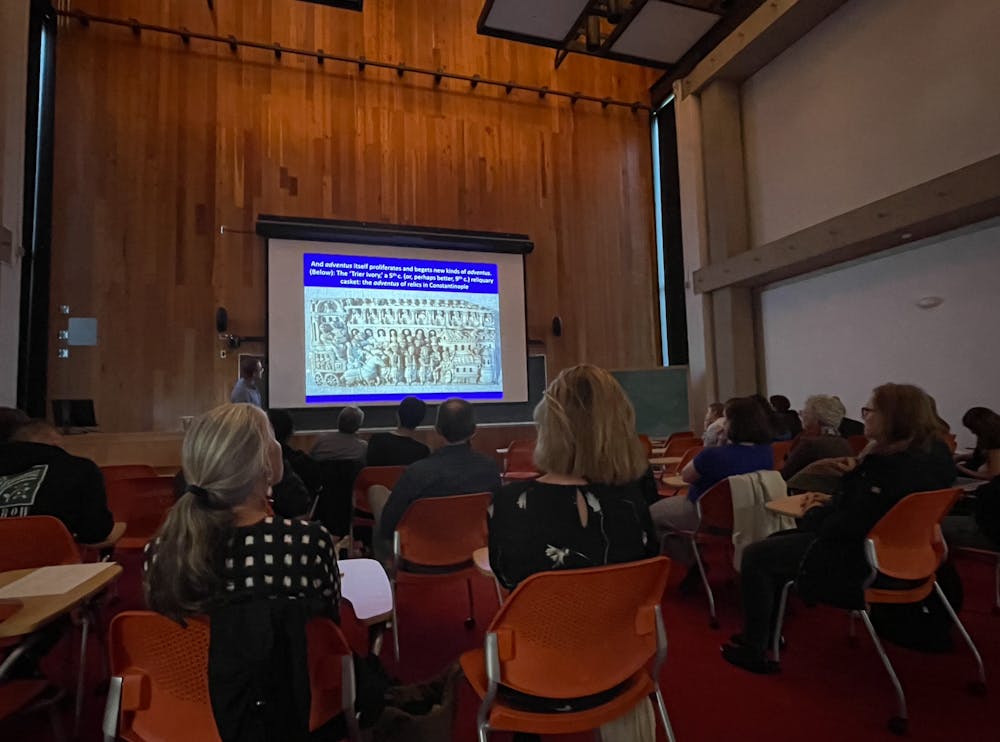Architecture, political standards, everyday ways of life — how did these concepts interact with each other in the Later Roman Empire? On Sept. 26, Dr. Hendrik W. Dey ’99, Middlebury alumnus and Professor of Art History at Hunter College of City University of New York (CUNY), shed some light on this question with a lecture elaborating on colonnaded streets' role in Later Roman societies.
The talk entitled “Colonnaded Streets and Urban Theater in the Later Roman Empire,” sponsored by the Department of History of Art and Architecture, took place in Johnson Memorial Building and made for an interesting look into Roman architectural history.
At Middlebury, Dr. Dey majored in classical studies and art history. He now specializes in architecture and urbanism in Europe and the Mediterranean Basin between late antiquity and the Middle Ages. His most recent book, “The Making Of Medieval Rome: A New Profile of the City, 400 – 1420,” won the Bridge Book Award in 2022 for the American Non-Fiction category.
Dey’s lecture provided a glimpse into the content of this book. In the late Roman Empire, grand colonnaded streets were a revolutionary characteristic in leading cities. Why were they important? How did they function? Dey’s presentation gave an overview of the questions: colonnaded streets reshaped the cityscapes to fulfill the political needs of the late Roman political offices. These streets gradually became the core figure of Roman cities and eventually influenced Roman citizens’ perception of urban life.
The lecture began with a brief history of the late Roman Empire. From 235 B.C. to 285 B.C., the Roman Empire experienced a period of civil war, foreign invasion, political instability, and economic disintegration known as the Crisis of the Third Century.
Amidst this political chaos, the Late Roman emperors sought ways to revive the “dignity of the imperial office,” said Dey. As a result, a 600-yard-long, two-story-tall colonnaded street that extended from the city gate to the imperial palace was built in Milan — the city that replaced Rome as the center of the empire — to function as a stage for emperors to display their power.
“Every time a late Roman emperor leaves their house to go out into the city or comes to the city from somewhere else, it is a processional cycle. It is a ritual, ceremonial occasion where everybody has a part to play. Every citizen’s supposed to carry out their own cheer,” explained Dey. Each citizen had their own place to cheer in the ceremonies (celebrating the emperor’s victory, travel, or return), and chanting lines for the emperor were carved on the stones. The same kind of colonnaded street was also built in Rome and every major city at the time.
Unsatisfied with merely changing the cities, the emperors rebuilt them entirely with colonnaded streets to connect the city’s architecture to a larger imperial will. Dr. Dey explained how the colonnaded streets conveyed political values: the statues of political icons were placed on colonnaded streets that were slightly tilted, which made the citizens feel presided over by imperial iconography on a seemingly endless road.
The final portion of Dey’s talk discussed that as the colonnaded streets became an essential figure of cities, people’s perceptions of cityscapes changed. Colonnaded streets became central to everyday citizen’s understanding of urban life in the Later Roman Empire.




